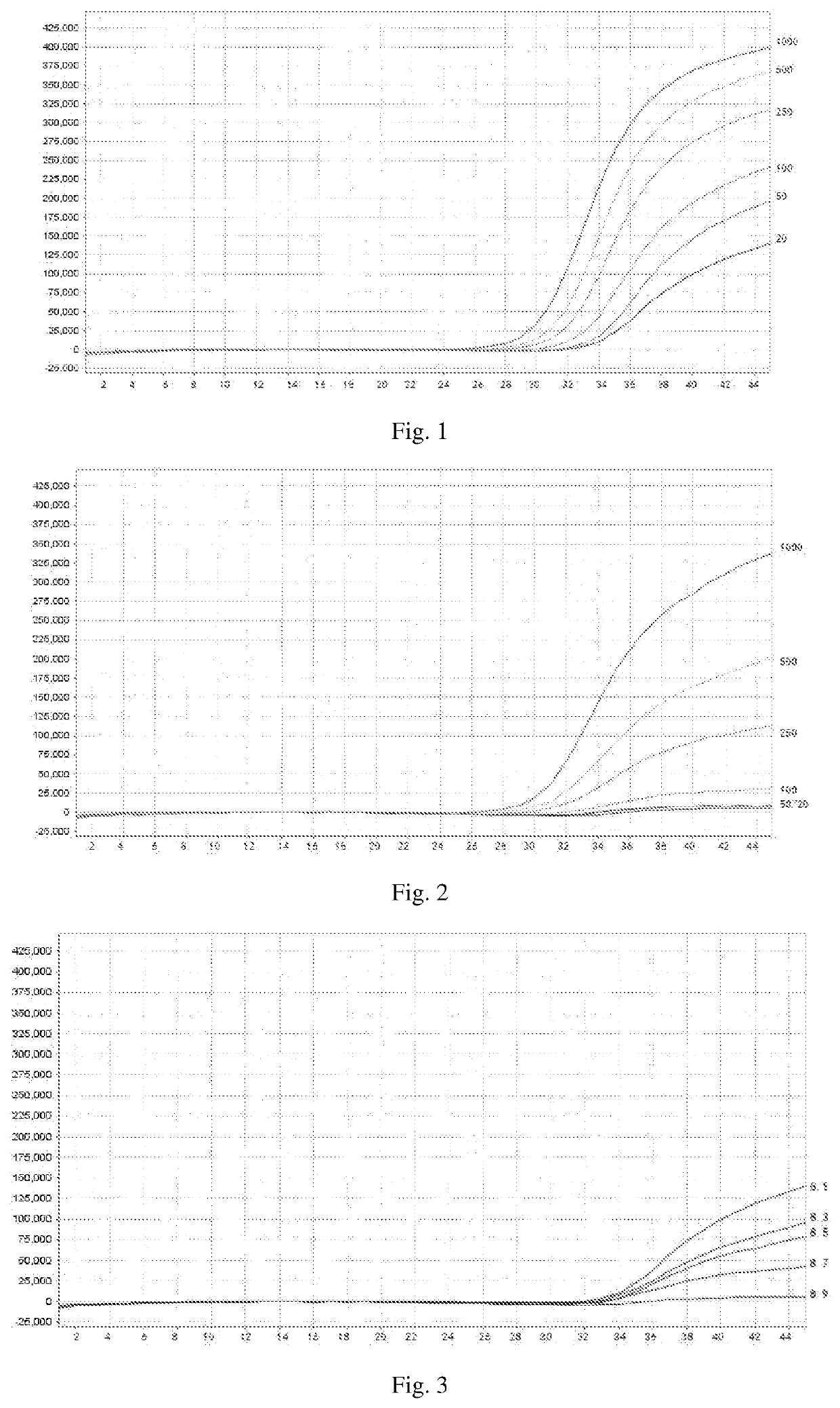Sample nucleic acid measurement test kit, reagent, and application thereof
a nucleic acid and sample technology, applied in the field of bioscience and biotechnology, can solve the problems of inefficient pcr amplification reaction, slow detection speed, poor subsequent pcr amplification effect, etc., to reduce the chance of increasing manual errors, increase the sensitivity and accuracy of sample nucleic acid detection, and save detection time
- Summary
- Abstract
- Description
- Claims
- Application Information
AI Technical Summary
Benefits of technology
Problems solved by technology
Method used
Image
Examples
example 1
cid Detection Reagent
[0053]The sample nucleic acid detection reagent in this example includes a nucleic acid extraction solution and a PCR reaction solution, and the compositions thereof are as follows:
[0054]The nucleic acid extraction solution: NaOH 10 mM to 100 mM, Tris-HCl 1 mM to 25 mM, Chelex-100 2% to 5% (w / v), EDTA 0.1% to 0.4% (w / v), pH=10.5 to 12.5.
[0055]The PCR reaction solution (pH=8.0 to 9.0) includes Tris-HCl 5 mM to 75 mM, and further includes dNTPs, KCl, Mg2+ and a pair of primers. When fluorescent PCR detection is used, the PCR reaction solution further includes a fluorescent dye such as SYBR Green, or a fluorescent probe such as TaqMan, preferably a TaqMan fluorescent probe. The PCR reaction solution may further include an enzyme mixture. Of course, the enzyme mixture and the PCR reaction solution may be stored separately, and the enzyme mixture is added to the PCR reaction solution when a nucleic acid amplification reaction is required. When the nucleic acid in the...
example 2
cleic Acid Extraction Step
[0063]The following sample nucleic acid extraction is carried out by using the nucleic acid detection reagent in Example 1, and can be classified into the following two sample nucleic acid extraction methods according to the sample:
[0064]Scheme 1:
[0065]1. Taking 200 μl of the sample to be tested, adding 200 μl of the concentration solution, and after shaking and mixing, centrifuging at 12,000 rpm for 10 min;
[0066]2. Discarding the supernatant and adding 50 μl of nucleic acid extraction solution to the precipitate;
[0067]3. After shaking and mixing, carrying out 100° C. water bath or dry bath for 10 min, then centrifuging at 12,000 rpm for 10 min, taking the supernatant, which is the extracted sample nucleic acid solution for PCR amplification, or storing at −20° C.±5° C. for future use.
[0068]Scheme 2:
[0069]1. Taking 100 μl of the sample to be tested, and after shaking and mixing, centrifuging at 12,000 rpm for 10 min, discarding the supernatant, and adding 5...
example 3
nt PCR Detection
[0072]The PCR detection system was 40 μl, the PCR reaction solution was dispensed into PCR reaction tubes in portions per person, and transferred to the sample processing area. 4 to 20 μl of the sample nucleic acid solution extracted in Example 2 was respectively added to the corresponding reaction tubes, and the reaction tubes were tightly capped, and transferred to a detection zone for PCR amplification. Each reaction tube was placed in a PCR machine in a certain order, and PCR detection program and detection fluorescence were set for fluorescence PCR amplification.
[0073]When detecting hepatitis B virus (HBV) in serum or plasma samples, 40 μl of a PCR detection system was prepared, in which the extracted sample nucleic acid solution was 20 μl and the PCR reaction solution was 20 μl.
[0074]When detecting the human B27 gene in the whole blood sample, the PCR detection system was 40 μl, in which the extracted sample nucleic acid solution was 4 μl and the PCR reaction s...
PUM
| Property | Measurement | Unit |
|---|---|---|
| pH | aaaaa | aaaaa |
| pH | aaaaa | aaaaa |
| volume | aaaaa | aaaaa |
Abstract
Description
Claims
Application Information
 Login to View More
Login to View More - R&D
- Intellectual Property
- Life Sciences
- Materials
- Tech Scout
- Unparalleled Data Quality
- Higher Quality Content
- 60% Fewer Hallucinations
Browse by: Latest US Patents, China's latest patents, Technical Efficacy Thesaurus, Application Domain, Technology Topic, Popular Technical Reports.
© 2025 PatSnap. All rights reserved.Legal|Privacy policy|Modern Slavery Act Transparency Statement|Sitemap|About US| Contact US: help@patsnap.com

